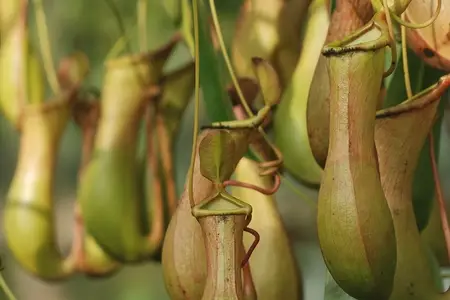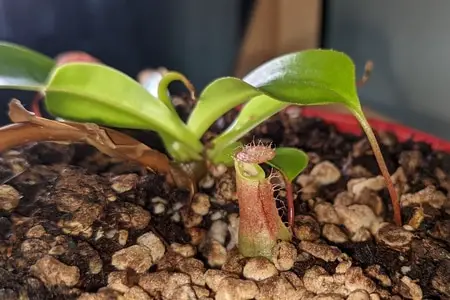Watering a Pitcher plant appropriately means finding the perfect balance between underwatering and overwatering. When I got my first Nepenthes, figuring out the watering and the other care considerations was not easy. After owning multiple healthy Nepenthes, I share what I have learned about watering pitcher plants in this article.
Pitcher plants must be watered often to keep the soil humid at all times without it drying out completely. Water until the soil is moist throughout and do not leave the plant standing in water for multiple days. Never employ tap water or bottled water; only use distilled water, reverse osmosis water, or rainwater.
Watering Pitcher plants incorrectly can kill Pitcher plants, and making small mistakes will slow down their growth. So, let’s get into the details of how to water your Pitcher plant to perfection.

Pitcher Plant Watering
At a glance summary: Pitcher Plant Watering
| Watering Frequency | Once or twice a week to ensure the soil remains humid. |
| Water Type | Use distilled, reverse osmosis or rain water. |
| Humidity Requirement | Do not grow pitcher plants sitting in water as it causes rotting issues. Instead, water often and employ a humidifier. |
| Pitcher plant fluid | Do not fill up the pitchers; healthy plants produce digestive juices in the pitchers. |
| Over watering signs | Yellow leaves and root rotting. |
| Under watering signs | Dried up leaves and stems of brownish color. |
1- Get the correct water. Choosing the wrong water type can kill Pitcher plants.
Pitcher plants are unique in which type of water they require. Please do not attempt to water your Pitcher plant with tap water or bottled water, as it can be extremely harmful.
Pitcher plants are intolerant to nutrients and minerals. For that reason, they need to be watered with pure water sources that contain little to no additives.
Pitcher plants should only receive distilled water, reverse osmosis water, or rainwater. These three options are safe for pitcher plants and other carnivorous plants. Tap water and bottled water can be very harmful to pitcher plants, they cause mineral burns and mineral build-up in the soil.
If you have access to rain, rainwater is the free option. Distilled water can be found in grocery stores for about $1 a gallon. Reverse osmosis water is sold in water stores and some pharmacies. Personally, I use distilled water since it is cheap and available near me. Make sure to buy the distilled water jugs that are pure. Avoid any bottles that contain the works “additives for taste,” ” enhanced for flavor,” “electrolytes.”

2- Water Pitcher plants from the top until the soil is humid all around and water comes out of the drainage holes.
Pitcher plants thrive in humid environments. So, make sure to moisten the soil all around. The plant does not only need the water to produce food, but it likes the humidity of the soil.
Besides the watering, make sure you select the correct soil. This article can help you select soil for your pitcher plant.
3- Leave no more than an inch of water in the tray. Never water a pitcher plant before the tray has dried up completely, and never let the plant sit in water for long periods.
When watering your plant, make sure to employ a shallow tray and not fill it up too high. An inch of water is the recommended maximum depth because Nepenthes do not like to sit in water. If it gets full, empty the tray. It is better to let your plants sit in an empty tray than to let them sit in water for long periods.
The little water in the tray helps increase the humidity in the area and provides a reserve of water.
4- When the tray dries up completely, water the plant again until the soil is moist all around. Never let the soil dry out completely.
The watering frequency for your plant will vary throughout the year as temperature changes.
As a general rule, water Nepenthes every 3-4 days or when the soil is less humid. You must never let the soil dry out. Pitcher plants suffer greatly when the environment is dry as they are accustomed to humid habitats.
I water my pitcher plants twice a week year-round. Since my plants live indoors, I do not have to account for environmental changes.
Pitcher Plant Watering Tips and Advice
The list below covers critical points to consider when watering and caring for a pitcher plant. Pay close attention to all and ensure your plant stays healthy.
- Employ pots with drainage: Technically, drainage holes are not a requirement for pitcher plants. However, employing pots with drainage lowers the changes of root rot and mold.
- Select the appropiate soil: To ensure the soil does not retain moisture excessively, make sure to employ soil with good drainage. A combination of 3 part sphagnum moss and 1 part perlite or silia sand are appropiate.This guide can help you choose the best soil for your Pitcher plant.
- Avoid terra cotta pots or clay pots: Such materials tend to absorb water from the soil. This characteristic is beneficial for many plants, but not for pitche plants. Those materials lower the humidity level and let too much water drain away from the soil. Also, terra cotta and clay tend to leach minerals to the ground. Plastic and ceramic containers are safe for pitcher plants.
- Employ a humidifier instead of a mister: Misting your plant provides minimal benefits. Instead of misting, consider employing a humidifier to increase the water content in the air.
- Monitor the water in your Pitchers: Check the pitchers in your plant and verify they contain liquid. A lack of water inside the pitcher is a sign of poor growing conditions. Is in many cases linked to uderwatering and lack of adequate lighting.
- Check your plant for root rot: Even though it is not very common, pitcher plants can suffer from root rot. When repotting pitcher plants, remove all the old soil and replace with fresh media. Then, make sure to clean the roots and examine them to check for root rot. It is easy to spot: dark and smushy spots or sections in the bulb of the plant.
- Research about dormancy needs: Some pitcher plants must undergo a winter dormancy. During dormancy, plants have different wtering needs. Make sure to adjust the watering frequency through the seasons.
- Avoid experimenting with other water sources: Most boiled water, tap water, bottled water, filtered water, pond water, and river water is unsuitable for pitcher plants. Test the water before using (with a TDS meter) or stick to pure water sources.
Should Pitcher Plants Sit in Water
Many plants thrive in damped or waterlogged conditions when they are placed in trays with water. Pitcher plants can sit in water, but only for short periods.
There are two general methods to water plants. You can water them in the standard fashion by pouring water from the top. You can also water the plant’s tray and wait until the plant absorbs it. The second option is often referred to as “watering from the bottom” or “the tray method.”
Preferably, water pitcher plants from the top and do not allow them to sit in water for extensive periods of several days or weeks. Pitcher plants can die due to root rot caused by overwatering.
You can water the plant until some liquid starts coming out of the drainage holes in the water tray. You can let some water stay in the tray, but it should be minimal. Keeping an inch of water is acceptable and not a significant threat. Never refill the tray with water. Instead, let the tray dry out completely before you water.
For best results, avoid watering pitcher plants from the bottom. Such a method does not provide any benefit and can cause root rot.
How to Water Hanging Pitcher Plants
Watering a hanging pitcher plant is not too complex. Here are the instructions.
When watering a hanging pitcher plant, water the plant from the top until the soil is humid and some liquid starts scaping the drainage holes; you must water again when the soil is less humid but never let it dry out.
Since hanging pitcher plants do not have a water saucer, your plant won’t have a water reserve. Consider palpating the soil every 1 to 2 days and confirm the dirt is still humid. Check the ground often to prevent it from drying out.
Pitcher plants thrive in high humidity environments. Consider misting your plant to increase the relative humidity in the background.
How to Water Sarracenia
Sarracenias grow in very humid to damped soil conditions. They thrive in humid environments and need to be watered often. Also, they should only receive mineral-free water, such as distilled water, reverse osmosis water, or rainwater. Avoid employing tap water or bottled water for Sarracenies, as the high mineral content can harm them.
Make sure you have the correct type of water before you attempt to water your plant. You can buy distilled water in most big box stores for an affordable fee of 1 dollar a gallon.
Sarracenias potted in containers with drainage can be watered using the tray method. Place the pot in a tray. Then, fill the tray with water. The plant will absorb the water from the tray, and the soil will remain humid.
Since Sarracenias require very wet soil, you must fill the water trays quite often. Add a few inches of water and refill when the water is almost gone. The dirt must never dry out. Instead, it should resemble boggy conditions as Sarracenias thrive in bigs.
Without drainage holes, you can water Sarracenias from the top. Always water thoroughly until the soil is wet all around. Water again as soon as the ground gets less wet but never dry.
Should You Put Water Inside Pitcher Plants?
Pitcher plants produce fluids inside their pitchers to digest prey. The liquid inside their pitchers contains enzymes that help break up any bug that falls inside the pitcher.
In the wild, Pitcher plants produce their own fluids. However, in some environments, Pitcher plants won’t make their own fluids.
Do not fill your pitcher plant with water if it is not producing its own fluids.Pitcher plants produce liquid inside their pitchers when conditions are optimal. Improper conditions, such as a lack of humidity and insufficient water can cause a pitcher plant to stop producing digestive juices.

You can read this guide on Pitcher plant care and figure out what can improve your setup. Once your plant is happy, it will start producing fluids. The presence of liquid inside the pitchers is a sign of healthy growing conditions.
There are some scenarios where it is recommended to add water to Pitcher plants:
- Some types of pitcher plants, such as sarracenia purpurea collect water with their pitchers. If the plant does not have access to rain water, you can consider adding some water. Use distilled water or rainwater to refill the pitcher
- Add water if you spilled the water out of a pitcher. Most plant won’t produce fluids fast enough to recuperate a spill.
- When pitcher plants are shipped in the mail they lose all their fluids. You can add water to ensure the pitchers remain healthy for a longer time.
How do you add water to pitcher plants?
First of all, make sure only to employ distilled, reverse osmosis, or rainwater. Anything else is unsuitable. Then, add water to the pitcher slowly until you reach no more than 1/4 to 1/3 of the pitcher’s height.
This section covered a summary of the matter. Learn all about when to fill your pitcher plant with water by reading this article. Also, it will give you easy steps on how to make your pitcher plant start producing fluids.
Pitcher Plant Care Guide
| Care Consideration | Recommendation |
|---|---|
| Lighting: | Expose to more than 10 hours of natural or artificial light. LED or fluorescent lights are suitable for indoor locations. |
| Watering: | Employ pure water sources such as distilled water, rainwater, or reverse osmosis water. Water constantly and keep the soil humid at all times. |
| Soil: | Do not employ standard potting media (enriched soil). Instead, use nutrient-free carnivorous plant soil. Carnivorous plant soil can be made up of peat moss or sphagnum moss and perlite or silica sand. The ratios are not critical, but a 3 to 1 ratio of moss and perlite is a suitable mixture. |
| Humidity: | > 50% |
| Trimming: | Remove dead leaves to promote growth. |
| Feeding: | Outdoor Pitcher plants capture bugs on their own. Indoor Pitcher plants need to be fed at least once a month to supplement their diet. You can employ mealworms, bloodworms, crickets, flies, fish flakes, or other small insects. Do not feed human food. This guide can help you learn which bugs to employ and how to do it: What To Feed a Pitcher Plant: A Comprehensive List (Plus Feeding Tips) |
| Fertilizers: | Avoid fertilizing unless advanced. |
| Repotting: | Repotting is not critical, but yearly repotting can promote growth. |
| Dormancy: | Some pitcher plant varieties require a yearly dormancy. Nepenthes tropical pitcher plants do not require dormancy. |
| Best indoor Pitcher plant varieties: | Tropical Pitcher plants can grow in indoor growing. |

